12 min read • Private equity
The insight: Keeping an eye on the horizon
European private equity should stay on track despite the bumpy road ahead


INTRODUCTION
The rapid rebound from the economic effects of COVID-19 has given way to a new set of macro and geopolitical challenges. The war in Ukraine and the ensuing energy crisis combined with soaring inflation and rapidly rising interest rates have created a more uncertain and volatile outlook in Europe. Yet against these unraveling conditions, private equity (PE) has continued to operate as an essential part of the economy. First half totals in 2022 for fundraising and investment are among some of the highest ever recorded, even if down from 2021’s record levels, while divestments have continued at a relatively steady pace despite the severe headwinds affecting many exit routes.
Arthur D. Little (ADL) and Invest Europe’s European PE survey, combined with Invest Europe’s first half data, bring together recent statistics that give fresh insight into the period just passed, with fund manager and investor opinion that informs us about the path forward for the industry. Both general partners (GPs) and limited partners (LPs) expect a more challenging environment that will have repercussions for fundraising, investment, and divestment activity in the near term. Longer term, however, there are positive expectations for fundraising as investors foresee commitments to private equity to be as high — or higher — than they are today.
PE firms and their investors are fully aware of the risks — from inflation and supply chain disruption to rapidly rising interest rates and geopolitical instability — but are also clearly focused on the opportunities.
Helping portfolio companies to embrace the future through operational improvements focused on digitalization and sustainability are seen as key ways to unlock value, alongside bolt-on acquisitions and measures to drive internationalization and organic growth.
Understanding, embracing, and delivering on environmental, social, and governance (ESG) represents one of the greatest challenges for the PE industry. It is one that GPs are addressing, with the vast majority placing greater attention on ESG factors as well as issues surrounding diversity and inclusion. It is clear this is not a short-lived intention but a secular shift, with many GPs looking at the creation of “green” funds that would set a very clear direction for the industry for years and decades to come.
Together, the data from the first half of the year and the PE survey paint a clear picture of the challenges and the opportunities for European private equity. The industry has traversed a volatile period already in 2022 and expects more short-term uncertainty. But over the longer term, European private equity is preparing for a greener future, incorporating ESG factors even more firmly at its core, with the full support and commitment of investors.
1
ROBUST MEDIUM-TERM FUNDRAISING EXPECTATIONS
After a record year for European PE fundraising in 2021, institutional investors’ capital commitments to the asset class remained strong in the face of geopolitical and economic concerns. Funds raised €64 billion in the first half of 2022, in line with last year’s first half results, with continued strong performance across all segments, including private equity and venture capital.
UK and Ireland, and France and Benelux, continue to dominate fundraising on a geographical basis (see Figure 1). As ever, distribution of fundraising tends to reflect the domicile of funds rather than the ultimate destination of that capital, with investment in the first half of 2022 more evenly spread across the continent.
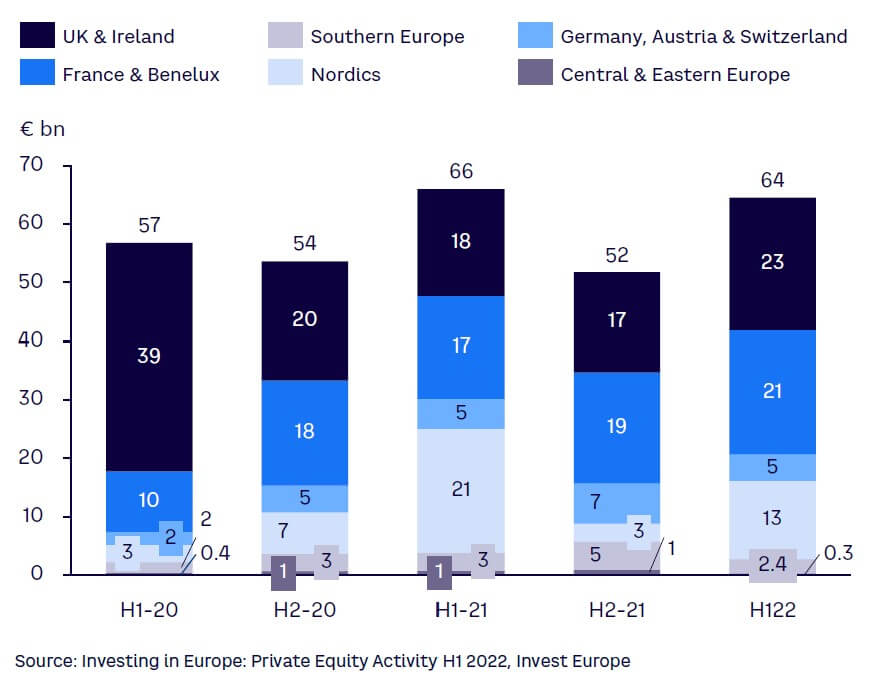
Despite continued strong support for PE funds in the first half of 2022, LPs and GPs alike are notably less optimistic about the short-term outlook for fundraising.
In addition to any macroeconomic concerns, there are technical considerations at play in PE allocations. With European equity markets seeing significant decreases since the start of the year, allocations by asset class going forward may be impacted. In other words, they may be overallocated to private equity, which could put new commitments on pause until portfolios are rebalanced. As a result, a large majority of GPs expect fundraising to be weaker in the coming 12 months compared with the prior year (see Figure 2).
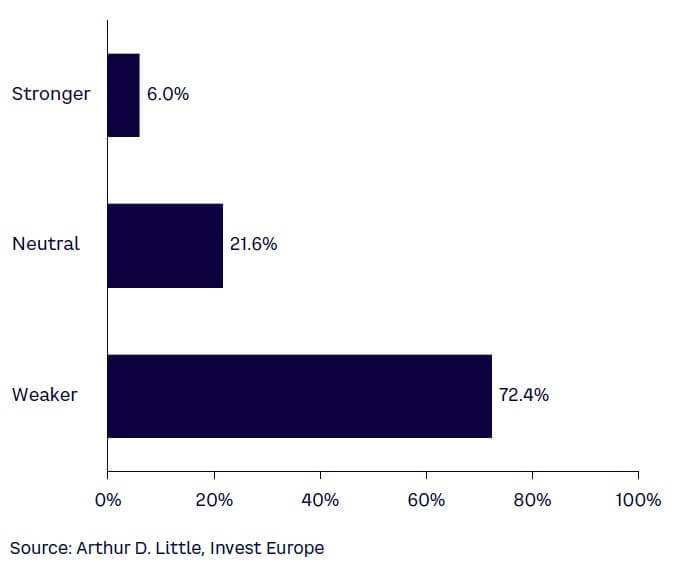
In the medium term, LPs remain drawn to the asset class and its proven ability to outperform and deliver superior returns throughout economic cycles. Nine out of 10 LPs expect investor allocations to private equity to be higher or unchanged over the next three years (see Figure 3).
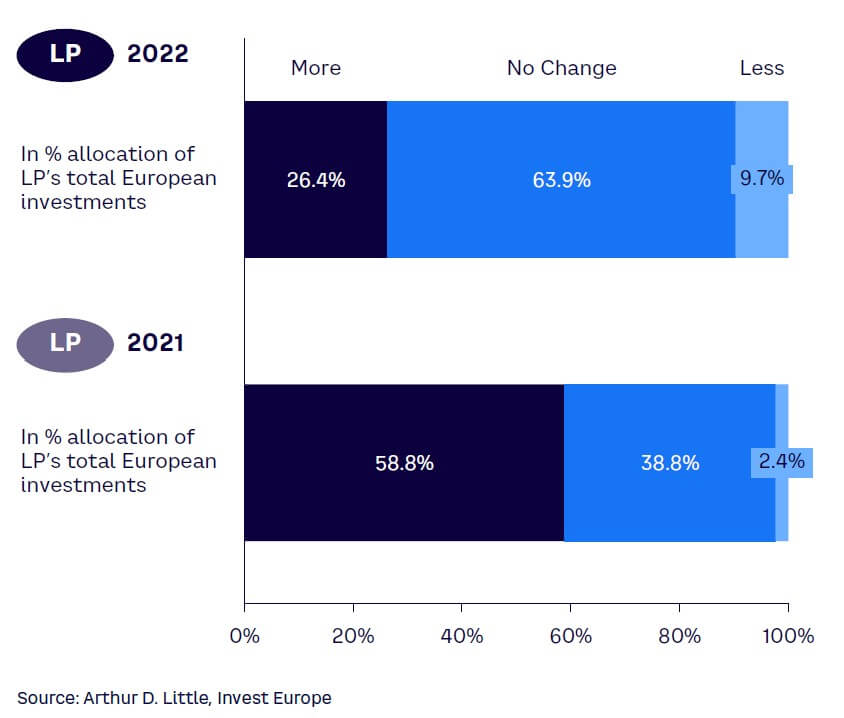
It is also important to note that the asset class is still evolving. New funds and vehicles are taking the PE asset class to a relatively untapped retail investor base. The pace and extent of this transformation is hard to assess but could unlock significant funds in new funding for private equity. In the PE survey, some 80% of the GP respondents confirmed an interest to market future funds to retail investors including high-net-worth individuals.
“I understand that the GPs may be less optimistic about future fundraising considering the macro situation. We believe that the coming years will offer great opportunities for PE, and we will continue to invest. Consistency in investing over cycles is key.”
Sofie Kulp-Tåg, Senior Investment Manager, Skandia Mutual Life Insurance Company
2
INVESTMENT OUTLOOK WEAKENS, CONFIDENCE PERSISTS IN TOP SECTORS
Persistent inflation, rising interest rates, and deteriorating macroeconomic conditions have increasingly weighed on market activity. Private equity is not immune, yet has seen resilient levels of investment. In the first half of 2022, the industry recorded €57 billion of investment, a 21% reduction compared with the immediately preceding six-month period (see Figure 4). Nevertheless, the total represents the third-best half-year performance from European PE over the past decade.
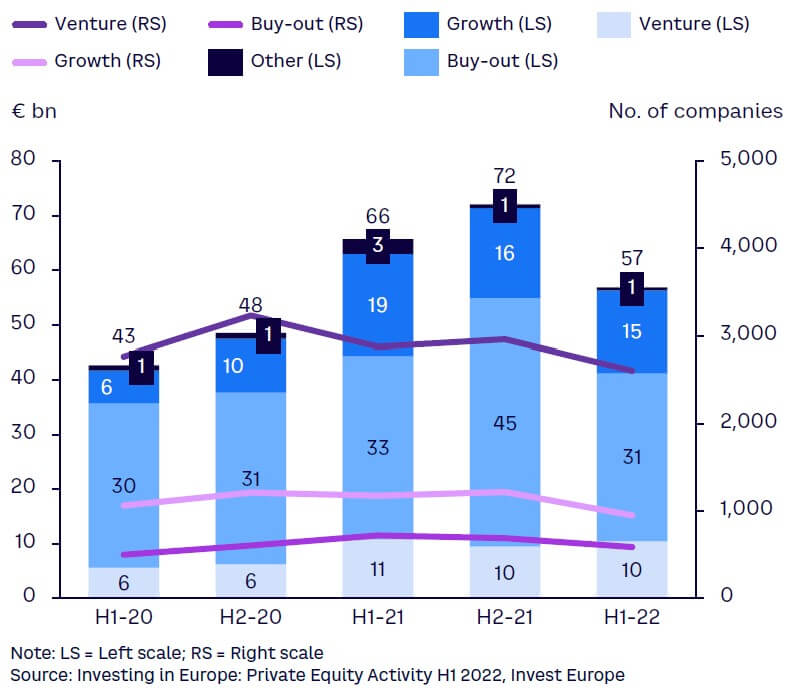
First half data shows that both venture capital and growth investment continued to track at levels close to records set last year, while buy-outs have normalized to be more in line with the averages of the last five years.
However, GPs are less optimistic about the outlook for investment over the coming 12 months than they were this time last year. Some 30% of GPs consider the outlook to be stronger compared with over 50% who forecasted better opportunities last year. In addition, fewer GPs are neutral on the investment outlook, while the number expecting a weaker environment has risen sharply to over 40% from under 10% last year (see Figure 5).
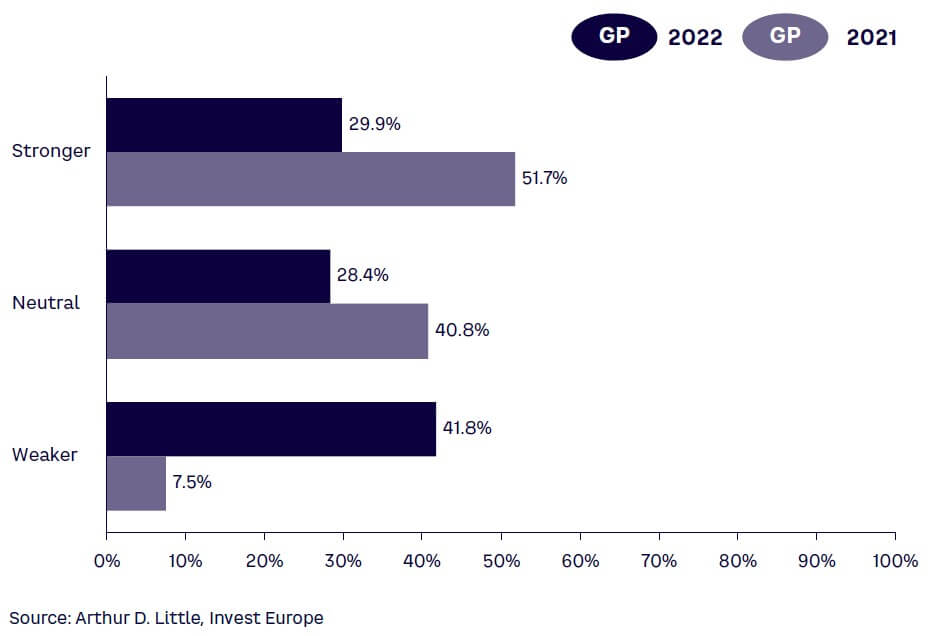
The investment focus of PE firms by type of transactions is shifting, reflecting in part the market dynamics and economic pressures affecting large businesses across Europe (see Figure 6). Over half of GPs expect more public-to-private transactions compared with under a quarter who did last year. Almost half also expect more corporate spin-offs, again illustrating the need for multinationals to rationalize their operations in the face of a downturn and deliver value to shareholders. In contrast, a smaller number of GPs expect more primary and secondary investments than last year — and a larger number expect fewer primary and secondary investments.
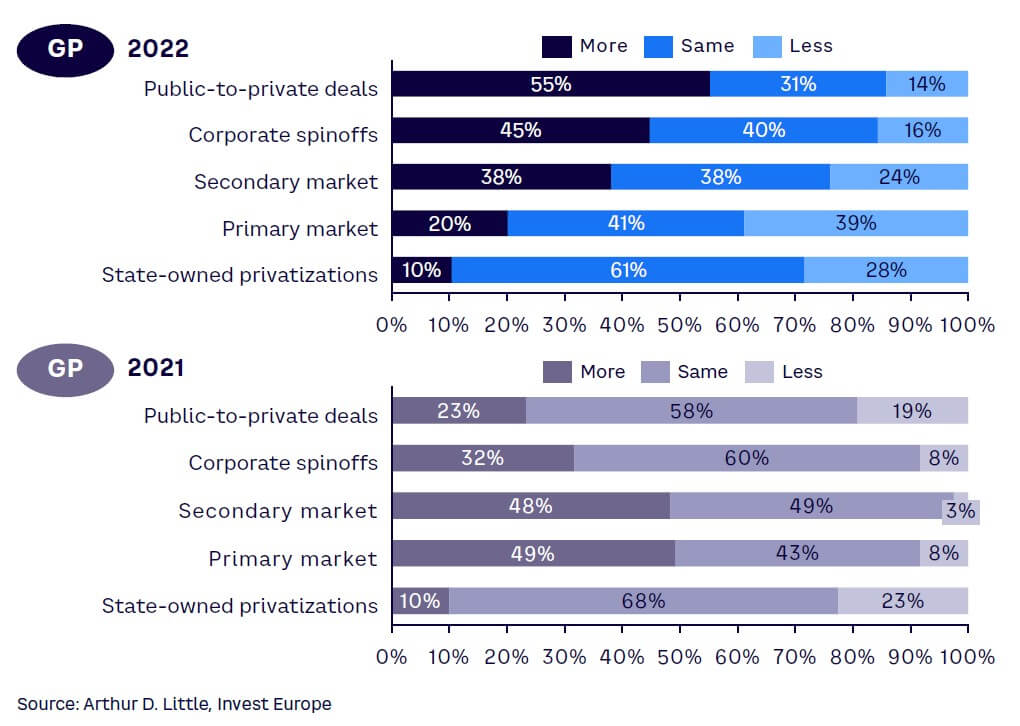
Confidence in finding opportunities in top sectors remains positive, with over 90% expecting at least the same degree of activity in each sector over the coming 12 months (see Figure 7). Expectations for renewable energy investments have strengthened, while those for life sciences and healthcare have weakened — but both remain strongly positive with more than 50% expecting higher investment.
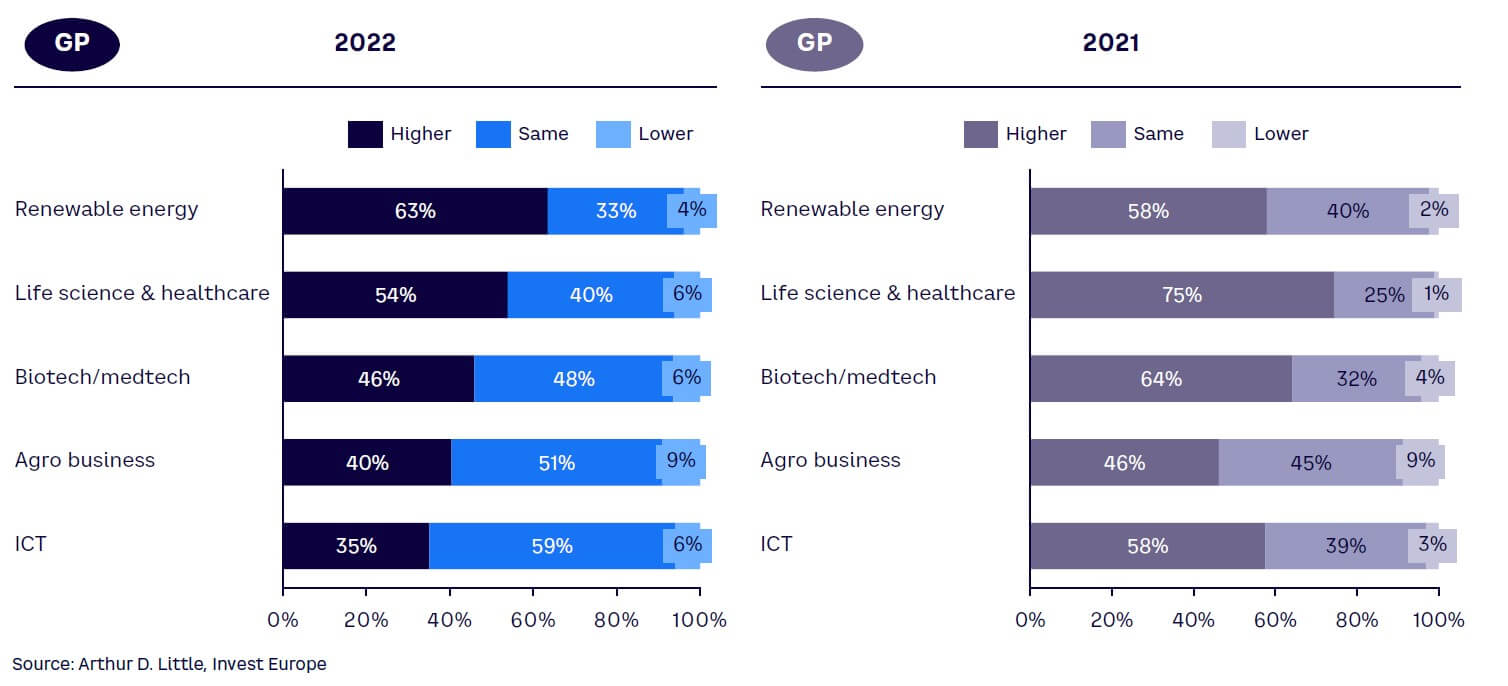
“There are noticeably fewer investment opportunities for transactions requiring significant leverage. I think that will remain the case for the remainder of the year.”
Louis Godron, Managing Partner, Argos Wityu
3
DIVESTMENT OUTLOOK WEAKENS IN WORSENING CLIMATE
PE divestment activity softened in the first half of 2022, coming off high levels last year. Funds divested some €14 billion of assets compared with €22 billion in the second half of last year, which was the strongest six-month period for exits since 2017 (see Figure 8).
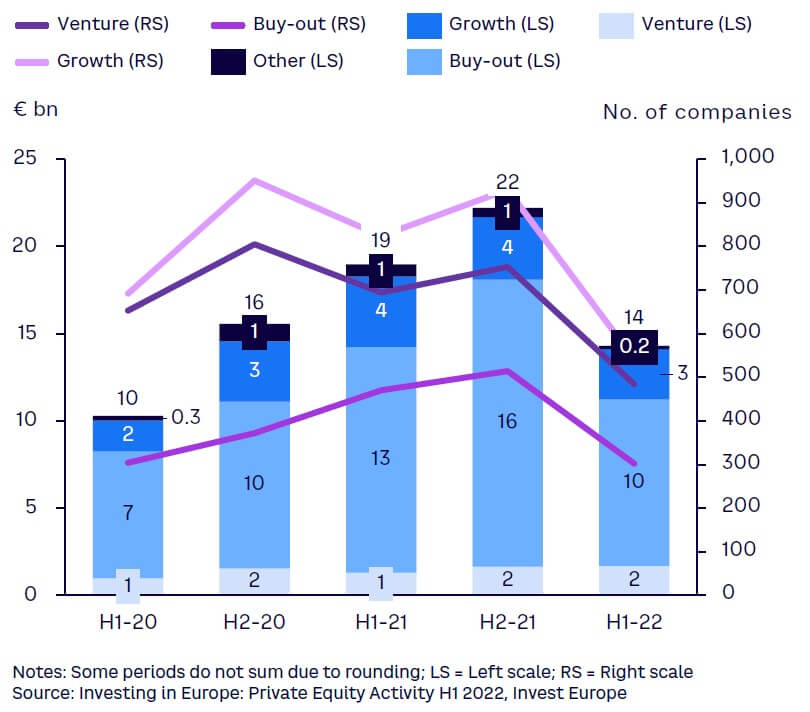
Venture capital divestments were marginally higher, however, illustrating the growing scale and success of the industry across Europe.
Macro concerns, high inflation, and rising interest rates — not to mention increased energy volatility and geopolitical tension — have impacted the exit environment. As a result, more than 60% of GPs expect divestments to be weaker over the coming 12 months, compared with just 3% who expected a weaker period this time last year (see Figure 9).
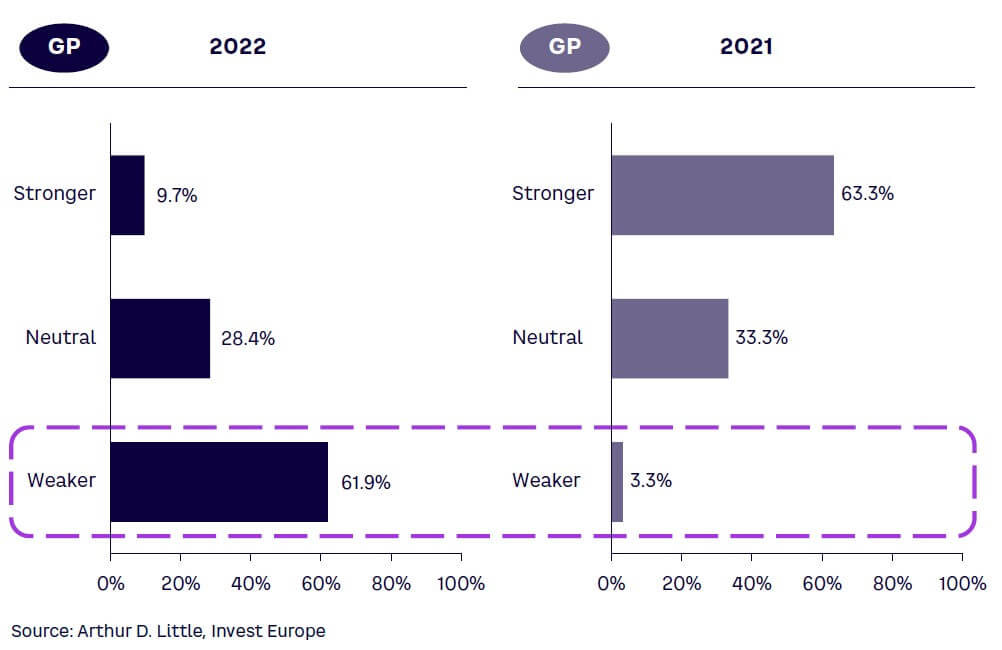
That shift in sentiment is mirrored by the number of GPs who now think that divestments will be stronger — under 10% — in contrast to over 60% last year.
It is important to note that GPs retain a strong degree of flexibility in when they choose to exit. The strong year for divestment last year, combined with the emergence of longer-duration funds and new vehicles to hold assets for the long term, provide options for both LPs and GPs.
Market volatility and uncertainty have affected GPs’ expected divestment routes as well (see Figure 10). Over a third expect proprietary situations to be more common in the next 12 months, while a quarter expect management and owner buy-backs to be more frequent. Expectations for IPOs have dropped sharply, echoing the decline in this exit route this year, which accounted for only 4% of divestment value at cost in the first half of the year. Seven out of eight GPs expect IPOs to be less common over the next year, while just 13% expect them to be the same or more frequent. Over a quarter of GPs also expect auctions to be less common, although more than seven out of 10 believe auctions will be at least as common over the next 12 months, indicating ongoing appetite for assets among strategic and rival PE funds.
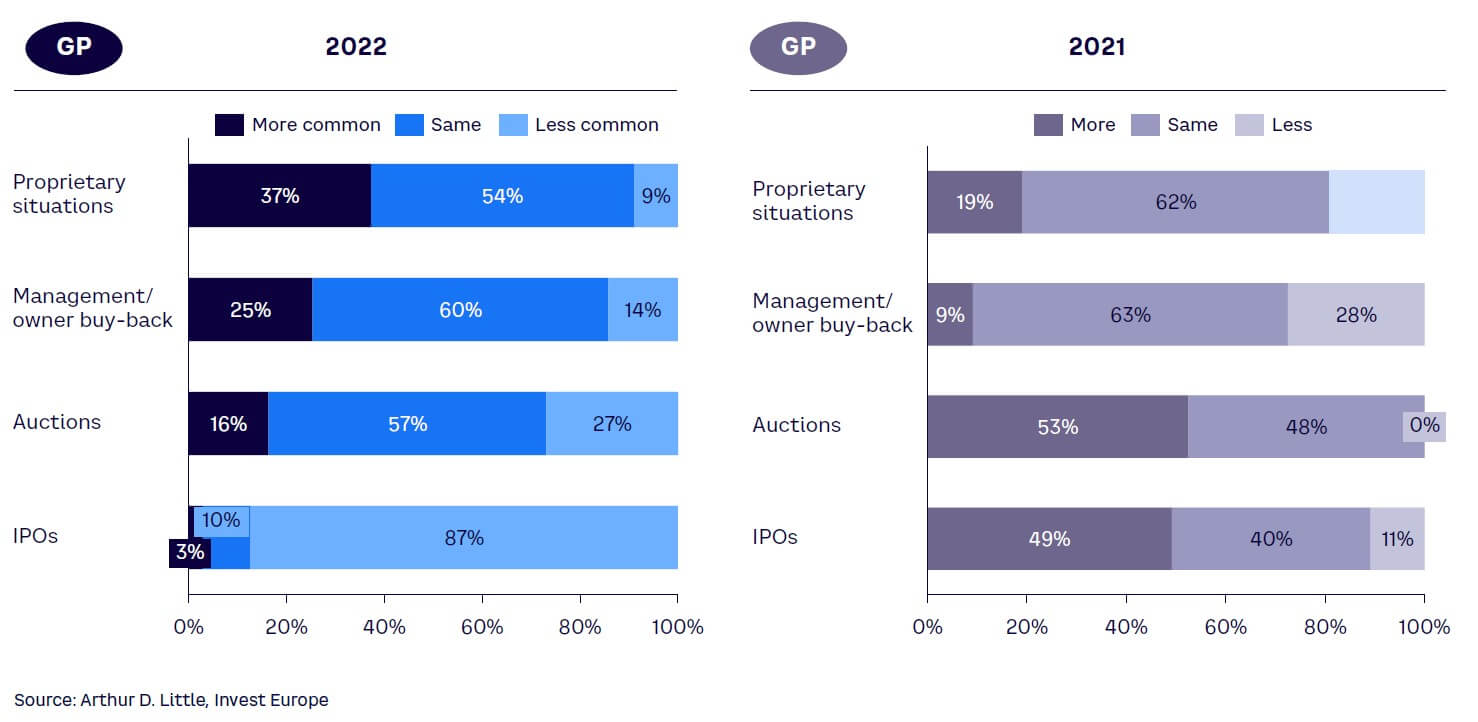
Valuations are a central consideration for PE firms, affecting both investment and divestment (see Figure 11). Comparable valuations in equity markets as well as the availability of financing have had a clear impact on asset price expectations. GP and LP views on the valuation outlook are very similar — in both cases more than 80% expect valuations to be lower in the coming 12 months compared with the previous 12 months. In contrast, last year, over 90% of LPs and GPs expected valuations to be higher, a dynamic that would have helped drive strong levels of divestment activity through the second half of 2021 and into early 2022.
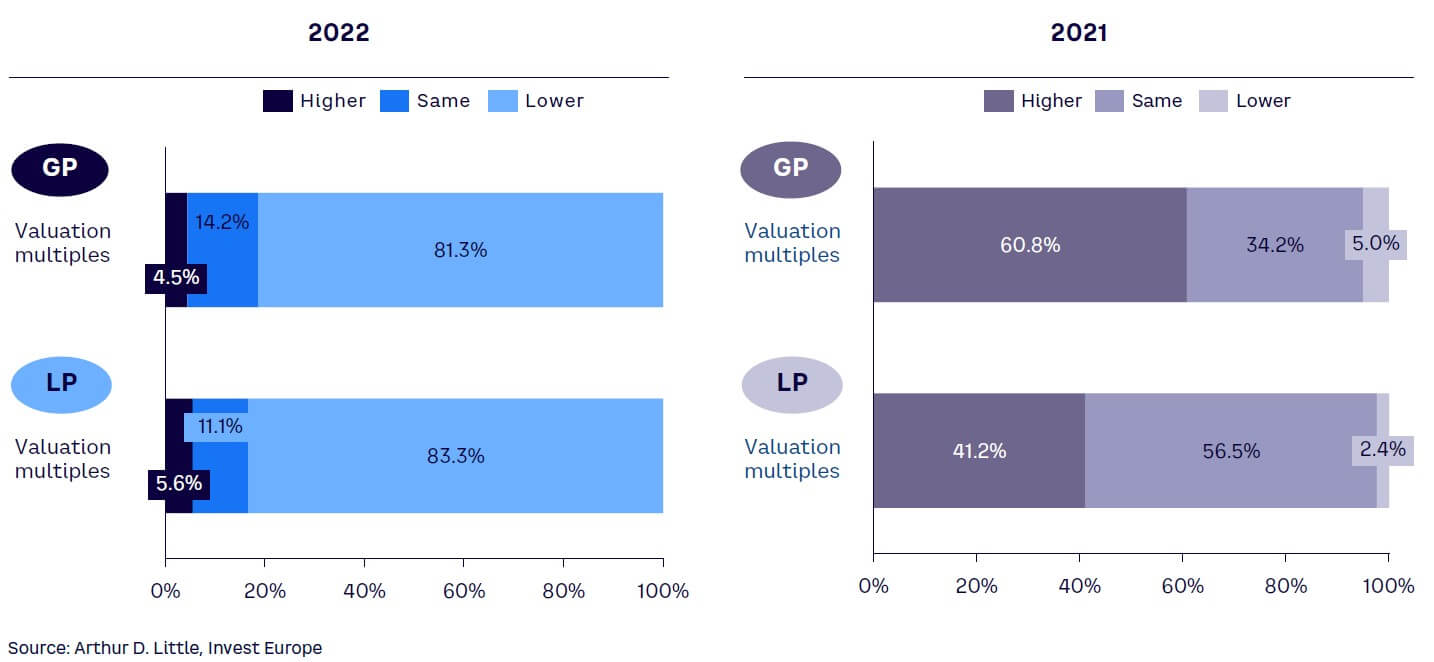
“In the current environment, we are spending a lot of time on operational improvement and growth, so the companies will be in a better position when exits occur in more beneficial circumstances.”
Kristof Vande Capelle, CFO, Gimv
4
INFLATION LEADS CONCERNS AMONG GPs & LPs
Among the headwinds facing the global economy and PE industry, both GPs and LPs rated high inflation as the most negative factor affecting business operations and performance (see Figure 12). Over 60% of GPs and more than half of LPs ranked higher costs and prices as the most negative or second-most negative issue.
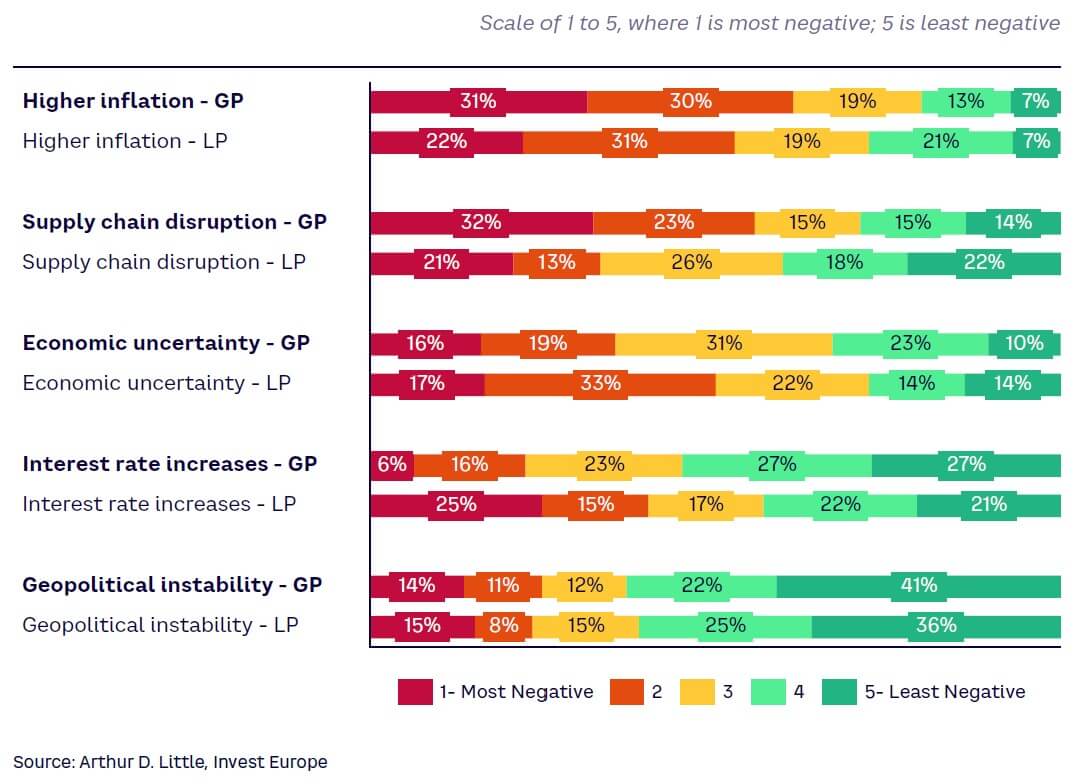
Among other factors there was some divergence of opinion. GPs with direct day-to-day experience of supply challenges rated supply chain disruption more negatively than LPs, while LPs who have exposure to a range of asset classes ranked interest rates more negatively. However, both groups were in relative agreement on the impact of geopolitical instability. Over 60% of GPs and LPs ranked it as the least or second-least negative factor affecting operations.
“High inflation is one of the biggest issues facing investors, as it negatively impacts so many PE return drivers — higher interest rates, higher costs, and the uncertainty of being able to maintain customer demand and margin in such a challenging and competitive environment.”
Merrick McKay, Head of Europe — Private Equity, abrdn
5
ATTENTION TO “GREEN” TOPICS, ESG & DIVERSITY TO INCREASE
The move to more sustainable investments, as well as robust ESG processes for fund managers, are clearly top of mind for both GPs and LPs alike. More than 90% of GPs and over 80% of LPs expect greater attention to ESG in their daily operations in the near future (see Figure 13). A large majority of GPs and half of LPs also expect more attention to diversity and inclusion as the industry makes greater efforts to increase participation of women and minorities at all levels.
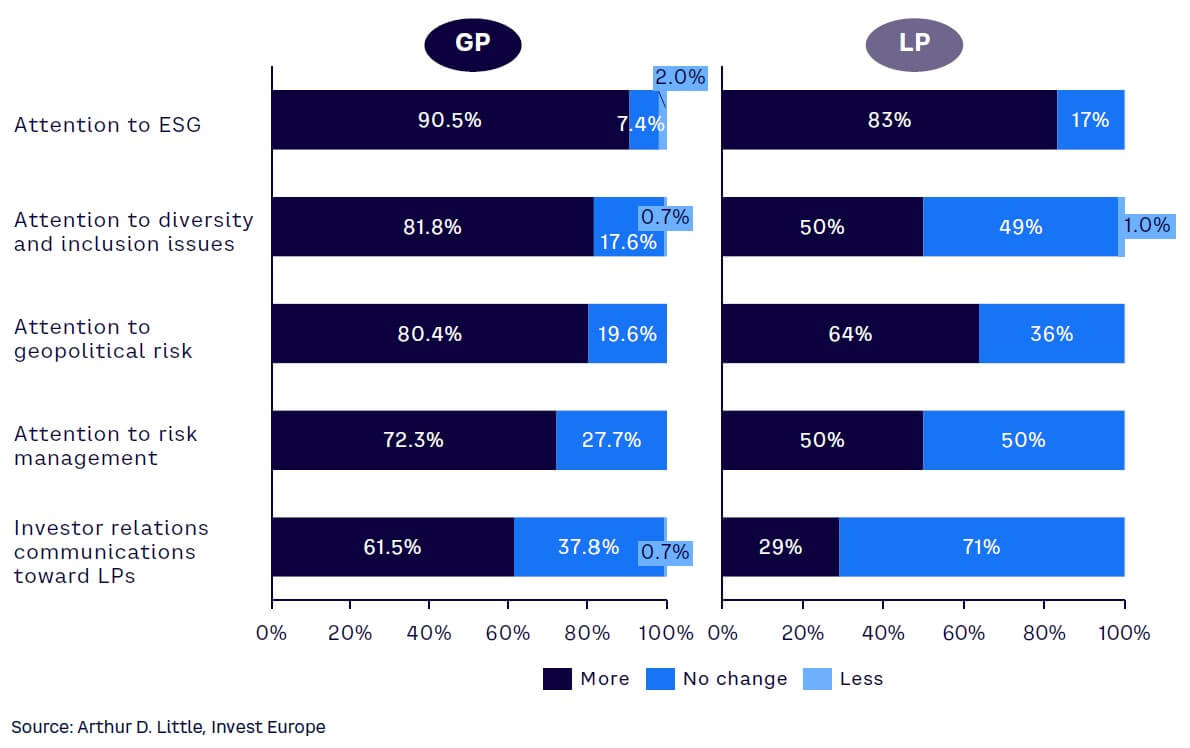
Against an uncertain and volatile macroeconomic and political backdrop, GPs and LPs are also intently focused on issues including geopolitical risk and risk management. Almost two-thirds of GPs also expect to communicate more with LPs, reflecting the need for enhanced investor reporting on sustainability as well as the importance of strong investor relations in more challenging periods. In contrast, under 30% of LPs expect greater communication, highlighting it as a lower-priority concern for investors. However, it is worth noting that GPs and LPs almost unanimously expect the same or a higher degree of attention to all key topics.
At the same time as they are adding to data management and reporting requirements, new rules, including the Sustainable Finance Disclosure Regulation, are seen as creating opportunities for the PE industry to focus on and deliver climate and ESG results (see Figure 14).
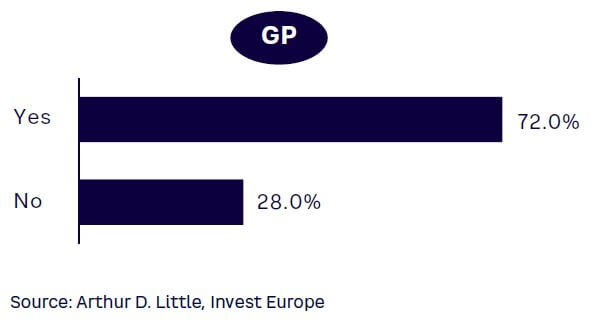
Almost three-quarters of GPs see advantages in registering “green” funds. That viewpoint is closely shared by a similar proportion of LPs who see more funds going “greener,” highlighting a very clear shift to more sustainable investment and greater ESG focus across the industry (see Figure 15).
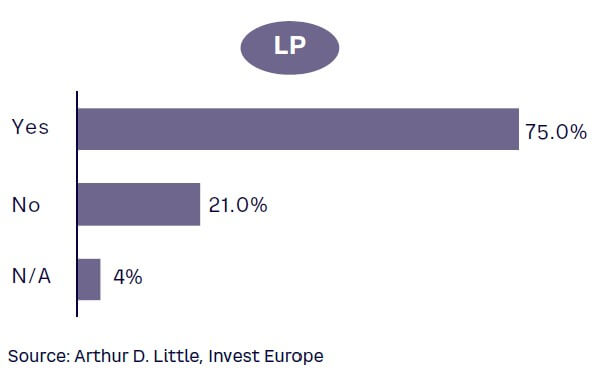
6
DIGITALIZATION REMAINS LEAD OPERATIONAL INITIATIVE FOR GPs
The operational focus of PE firms on improving portfolio companies is relatively little changed in the cooling economic climate. Digitalization remains the leading operational lever for change at companies, selected by over two-thirds of GPs, followed by acquisitions and organic growth (see Figure 16).
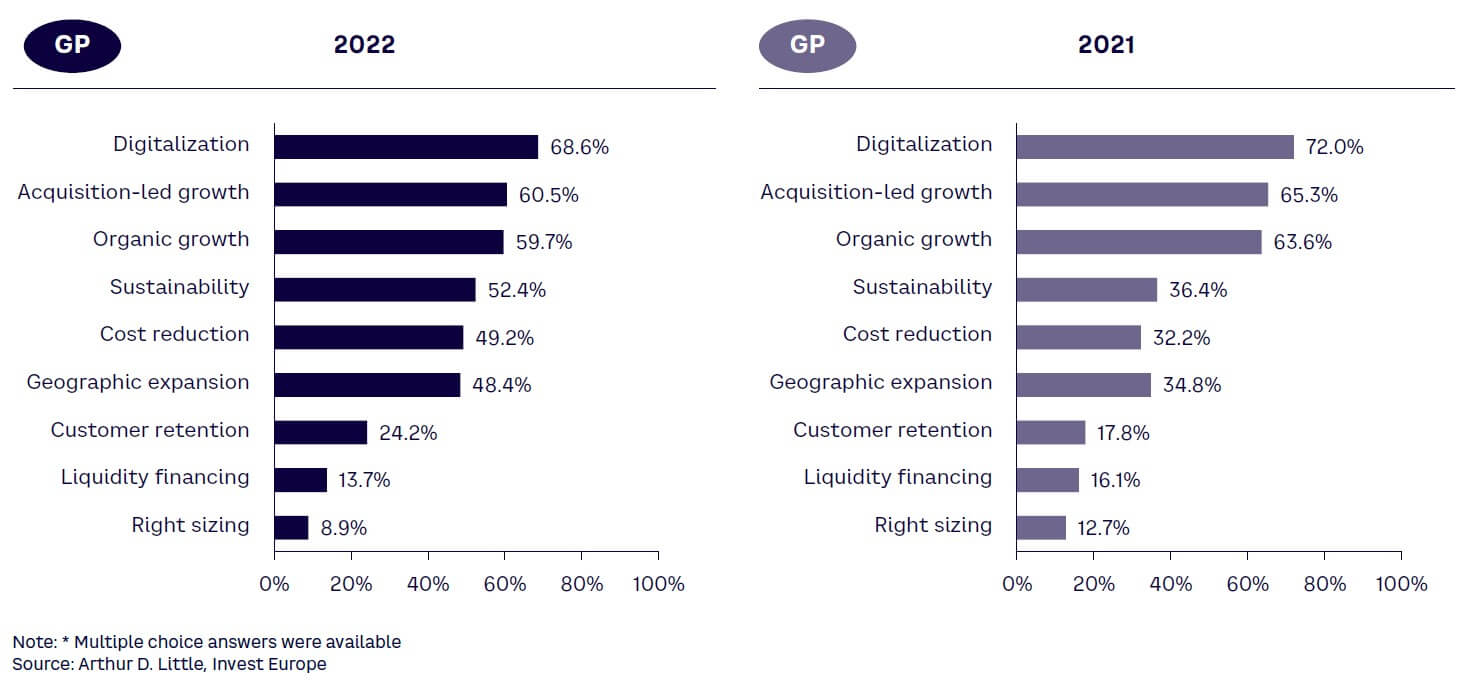
Actions to improve sustainability have become more important, reflecting earlier responses highlighting greater attention to ESG. Cost-reduction measures have also increased in importance for GPs, highlighting the need to control high inflation and higher input costs, including energy. Geographic expansion has also become more important as GPs look to diversify their portfolio companies’ products and services into a broader range of markets.
“At most of our portfolio companies, we have run — or are running — initiatives to increase digital maturity, while also using digital processes to become more cost-efficient.”
George Swirski, Co-Founder & Chairman, Abris
CONCLUSION
European private equity continues to grow and evolve, reacting to challenges and responding to opportunities. The macro headwinds that have developed this year are inescapable — rising inflation, geopolitical risk, higher interest rates, and the threat of recession — yet for agile managers, they highlight new routes to deploy capital and use various levers for operational improvements at companies.
Private equity has weathered the first half strongly with investment levels that, while down on last year’s result, are notably higher than the preceding period. There is further uncertainty ahead, but funds are preparing to embrace that, partly by targeting more public-to-privates and corporate carve-out transactions. The conditions enhance other opportunities as well, such as the potential for more investment in renewable energy or leveraging GPs’ operational expertise to drive value through measures focused on sustainability and geographic expansion, as well as digitalization and bolt-on acquisition strategies.
The short-term headwinds have not diminished the industry’s commitment to ESG; if anything, they have further enhanced it. There is a clear direction toward “greener” funds and investments that take climate and ESG considerations even more firmly into account, as the European PE industry adapts to some of the world’s most developed regulation on sustainable investment and disclosure.
It is private equity’s ability to take the long-term view that is at the heart of its relationship with investors. In the near term, technical considerations around LP allocations, as well as the ability to secure exits in uncertain market conditions, will weigh on fundraising. But in the medium term, the industry’s track record on performance over decades, rather than months and years, will sustain and help draw more capital into the asset class. Private equity is an active and integrated part of the European investment landscape, transforming businesses and supporting investors not only in good times, but also when the outlook darkens.
DOWNLOAD THE SURVEY SUMMARY
DOWNLOAD THE FULL REPORT
12 min read • Private equity
The insight: Keeping an eye on the horizon
European private equity should stay on track despite the bumpy road ahead

DATE

INTRODUCTION
The rapid rebound from the economic effects of COVID-19 has given way to a new set of macro and geopolitical challenges. The war in Ukraine and the ensuing energy crisis combined with soaring inflation and rapidly rising interest rates have created a more uncertain and volatile outlook in Europe. Yet against these unraveling conditions, private equity (PE) has continued to operate as an essential part of the economy. First half totals in 2022 for fundraising and investment are among some of the highest ever recorded, even if down from 2021’s record levels, while divestments have continued at a relatively steady pace despite the severe headwinds affecting many exit routes.
Arthur D. Little (ADL) and Invest Europe’s European PE survey, combined with Invest Europe’s first half data, bring together recent statistics that give fresh insight into the period just passed, with fund manager and investor opinion that informs us about the path forward for the industry. Both general partners (GPs) and limited partners (LPs) expect a more challenging environment that will have repercussions for fundraising, investment, and divestment activity in the near term. Longer term, however, there are positive expectations for fundraising as investors foresee commitments to private equity to be as high — or higher — than they are today.
PE firms and their investors are fully aware of the risks — from inflation and supply chain disruption to rapidly rising interest rates and geopolitical instability — but are also clearly focused on the opportunities.
Helping portfolio companies to embrace the future through operational improvements focused on digitalization and sustainability are seen as key ways to unlock value, alongside bolt-on acquisitions and measures to drive internationalization and organic growth.
Understanding, embracing, and delivering on environmental, social, and governance (ESG) represents one of the greatest challenges for the PE industry. It is one that GPs are addressing, with the vast majority placing greater attention on ESG factors as well as issues surrounding diversity and inclusion. It is clear this is not a short-lived intention but a secular shift, with many GPs looking at the creation of “green” funds that would set a very clear direction for the industry for years and decades to come.
Together, the data from the first half of the year and the PE survey paint a clear picture of the challenges and the opportunities for European private equity. The industry has traversed a volatile period already in 2022 and expects more short-term uncertainty. But over the longer term, European private equity is preparing for a greener future, incorporating ESG factors even more firmly at its core, with the full support and commitment of investors.
1
ROBUST MEDIUM-TERM FUNDRAISING EXPECTATIONS
After a record year for European PE fundraising in 2021, institutional investors’ capital commitments to the asset class remained strong in the face of geopolitical and economic concerns. Funds raised €64 billion in the first half of 2022, in line with last year’s first half results, with continued strong performance across all segments, including private equity and venture capital.
UK and Ireland, and France and Benelux, continue to dominate fundraising on a geographical basis (see Figure 1). As ever, distribution of fundraising tends to reflect the domicile of funds rather than the ultimate destination of that capital, with investment in the first half of 2022 more evenly spread across the continent.

Despite continued strong support for PE funds in the first half of 2022, LPs and GPs alike are notably less optimistic about the short-term outlook for fundraising.
In addition to any macroeconomic concerns, there are technical considerations at play in PE allocations. With European equity markets seeing significant decreases since the start of the year, allocations by asset class going forward may be impacted. In other words, they may be overallocated to private equity, which could put new commitments on pause until portfolios are rebalanced. As a result, a large majority of GPs expect fundraising to be weaker in the coming 12 months compared with the prior year (see Figure 2).

In the medium term, LPs remain drawn to the asset class and its proven ability to outperform and deliver superior returns throughout economic cycles. Nine out of 10 LPs expect investor allocations to private equity to be higher or unchanged over the next three years (see Figure 3).

It is also important to note that the asset class is still evolving. New funds and vehicles are taking the PE asset class to a relatively untapped retail investor base. The pace and extent of this transformation is hard to assess but could unlock significant funds in new funding for private equity. In the PE survey, some 80% of the GP respondents confirmed an interest to market future funds to retail investors including high-net-worth individuals.
“I understand that the GPs may be less optimistic about future fundraising considering the macro situation. We believe that the coming years will offer great opportunities for PE, and we will continue to invest. Consistency in investing over cycles is key.”
Sofie Kulp-Tåg, Senior Investment Manager, Skandia Mutual Life Insurance Company
2
INVESTMENT OUTLOOK WEAKENS, CONFIDENCE PERSISTS IN TOP SECTORS
Persistent inflation, rising interest rates, and deteriorating macroeconomic conditions have increasingly weighed on market activity. Private equity is not immune, yet has seen resilient levels of investment. In the first half of 2022, the industry recorded €57 billion of investment, a 21% reduction compared with the immediately preceding six-month period (see Figure 4). Nevertheless, the total represents the third-best half-year performance from European PE over the past decade.

First half data shows that both venture capital and growth investment continued to track at levels close to records set last year, while buy-outs have normalized to be more in line with the averages of the last five years.
However, GPs are less optimistic about the outlook for investment over the coming 12 months than they were this time last year. Some 30% of GPs consider the outlook to be stronger compared with over 50% who forecasted better opportunities last year. In addition, fewer GPs are neutral on the investment outlook, while the number expecting a weaker environment has risen sharply to over 40% from under 10% last year (see Figure 5).

The investment focus of PE firms by type of transactions is shifting, reflecting in part the market dynamics and economic pressures affecting large businesses across Europe (see Figure 6). Over half of GPs expect more public-to-private transactions compared with under a quarter who did last year. Almost half also expect more corporate spin-offs, again illustrating the need for multinationals to rationalize their operations in the face of a downturn and deliver value to shareholders. In contrast, a smaller number of GPs expect more primary and secondary investments than last year — and a larger number expect fewer primary and secondary investments.

Confidence in finding opportunities in top sectors remains positive, with over 90% expecting at least the same degree of activity in each sector over the coming 12 months (see Figure 7). Expectations for renewable energy investments have strengthened, while those for life sciences and healthcare have weakened — but both remain strongly positive with more than 50% expecting higher investment.

“There are noticeably fewer investment opportunities for transactions requiring significant leverage. I think that will remain the case for the remainder of the year.”
Louis Godron, Managing Partner, Argos Wityu
3
DIVESTMENT OUTLOOK WEAKENS IN WORSENING CLIMATE
PE divestment activity softened in the first half of 2022, coming off high levels last year. Funds divested some €14 billion of assets compared with €22 billion in the second half of last year, which was the strongest six-month period for exits since 2017 (see Figure 8).

Venture capital divestments were marginally higher, however, illustrating the growing scale and success of the industry across Europe.
Macro concerns, high inflation, and rising interest rates — not to mention increased energy volatility and geopolitical tension — have impacted the exit environment. As a result, more than 60% of GPs expect divestments to be weaker over the coming 12 months, compared with just 3% who expected a weaker period this time last year (see Figure 9).

That shift in sentiment is mirrored by the number of GPs who now think that divestments will be stronger — under 10% — in contrast to over 60% last year.
It is important to note that GPs retain a strong degree of flexibility in when they choose to exit. The strong year for divestment last year, combined with the emergence of longer-duration funds and new vehicles to hold assets for the long term, provide options for both LPs and GPs.
Market volatility and uncertainty have affected GPs’ expected divestment routes as well (see Figure 10). Over a third expect proprietary situations to be more common in the next 12 months, while a quarter expect management and owner buy-backs to be more frequent. Expectations for IPOs have dropped sharply, echoing the decline in this exit route this year, which accounted for only 4% of divestment value at cost in the first half of the year. Seven out of eight GPs expect IPOs to be less common over the next year, while just 13% expect them to be the same or more frequent. Over a quarter of GPs also expect auctions to be less common, although more than seven out of 10 believe auctions will be at least as common over the next 12 months, indicating ongoing appetite for assets among strategic and rival PE funds.

Valuations are a central consideration for PE firms, affecting both investment and divestment (see Figure 11). Comparable valuations in equity markets as well as the availability of financing have had a clear impact on asset price expectations. GP and LP views on the valuation outlook are very similar — in both cases more than 80% expect valuations to be lower in the coming 12 months compared with the previous 12 months. In contrast, last year, over 90% of LPs and GPs expected valuations to be higher, a dynamic that would have helped drive strong levels of divestment activity through the second half of 2021 and into early 2022.

“In the current environment, we are spending a lot of time on operational improvement and growth, so the companies will be in a better position when exits occur in more beneficial circumstances.”
Kristof Vande Capelle, CFO, Gimv
4
INFLATION LEADS CONCERNS AMONG GPs & LPs
Among the headwinds facing the global economy and PE industry, both GPs and LPs rated high inflation as the most negative factor affecting business operations and performance (see Figure 12). Over 60% of GPs and more than half of LPs ranked higher costs and prices as the most negative or second-most negative issue.

Among other factors there was some divergence of opinion. GPs with direct day-to-day experience of supply challenges rated supply chain disruption more negatively than LPs, while LPs who have exposure to a range of asset classes ranked interest rates more negatively. However, both groups were in relative agreement on the impact of geopolitical instability. Over 60% of GPs and LPs ranked it as the least or second-least negative factor affecting operations.
“High inflation is one of the biggest issues facing investors, as it negatively impacts so many PE return drivers — higher interest rates, higher costs, and the uncertainty of being able to maintain customer demand and margin in such a challenging and competitive environment.”
Merrick McKay, Head of Europe — Private Equity, abrdn
5
ATTENTION TO “GREEN” TOPICS, ESG & DIVERSITY TO INCREASE
The move to more sustainable investments, as well as robust ESG processes for fund managers, are clearly top of mind for both GPs and LPs alike. More than 90% of GPs and over 80% of LPs expect greater attention to ESG in their daily operations in the near future (see Figure 13). A large majority of GPs and half of LPs also expect more attention to diversity and inclusion as the industry makes greater efforts to increase participation of women and minorities at all levels.

Against an uncertain and volatile macroeconomic and political backdrop, GPs and LPs are also intently focused on issues including geopolitical risk and risk management. Almost two-thirds of GPs also expect to communicate more with LPs, reflecting the need for enhanced investor reporting on sustainability as well as the importance of strong investor relations in more challenging periods. In contrast, under 30% of LPs expect greater communication, highlighting it as a lower-priority concern for investors. However, it is worth noting that GPs and LPs almost unanimously expect the same or a higher degree of attention to all key topics.
At the same time as they are adding to data management and reporting requirements, new rules, including the Sustainable Finance Disclosure Regulation, are seen as creating opportunities for the PE industry to focus on and deliver climate and ESG results (see Figure 14).

Almost three-quarters of GPs see advantages in registering “green” funds. That viewpoint is closely shared by a similar proportion of LPs who see more funds going “greener,” highlighting a very clear shift to more sustainable investment and greater ESG focus across the industry (see Figure 15).

6
DIGITALIZATION REMAINS LEAD OPERATIONAL INITIATIVE FOR GPs
The operational focus of PE firms on improving portfolio companies is relatively little changed in the cooling economic climate. Digitalization remains the leading operational lever for change at companies, selected by over two-thirds of GPs, followed by acquisitions and organic growth (see Figure 16).

Actions to improve sustainability have become more important, reflecting earlier responses highlighting greater attention to ESG. Cost-reduction measures have also increased in importance for GPs, highlighting the need to control high inflation and higher input costs, including energy. Geographic expansion has also become more important as GPs look to diversify their portfolio companies’ products and services into a broader range of markets.
“At most of our portfolio companies, we have run — or are running — initiatives to increase digital maturity, while also using digital processes to become more cost-efficient.”
George Swirski, Co-Founder & Chairman, Abris
CONCLUSION
European private equity continues to grow and evolve, reacting to challenges and responding to opportunities. The macro headwinds that have developed this year are inescapable — rising inflation, geopolitical risk, higher interest rates, and the threat of recession — yet for agile managers, they highlight new routes to deploy capital and use various levers for operational improvements at companies.
Private equity has weathered the first half strongly with investment levels that, while down on last year’s result, are notably higher than the preceding period. There is further uncertainty ahead, but funds are preparing to embrace that, partly by targeting more public-to-privates and corporate carve-out transactions. The conditions enhance other opportunities as well, such as the potential for more investment in renewable energy or leveraging GPs’ operational expertise to drive value through measures focused on sustainability and geographic expansion, as well as digitalization and bolt-on acquisition strategies.
The short-term headwinds have not diminished the industry’s commitment to ESG; if anything, they have further enhanced it. There is a clear direction toward “greener” funds and investments that take climate and ESG considerations even more firmly into account, as the European PE industry adapts to some of the world’s most developed regulation on sustainable investment and disclosure.
It is private equity’s ability to take the long-term view that is at the heart of its relationship with investors. In the near term, technical considerations around LP allocations, as well as the ability to secure exits in uncertain market conditions, will weigh on fundraising. But in the medium term, the industry’s track record on performance over decades, rather than months and years, will sustain and help draw more capital into the asset class. Private equity is an active and integrated part of the European investment landscape, transforming businesses and supporting investors not only in good times, but also when the outlook darkens.


